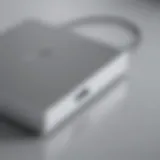Exploring Wireless Charging Technology for iPad Pro 12.9


Product Overview
The iPad Pro 12.9 stands as one of Apple's flagship tablets, designed to deliver unparalleled performance while catering to a diverse range of users, from artists to business professionals. Its premium build, extensive feature set, and powerful capabilities make it a cornerstone in the Apple ecosystem.
Foreword to the Apple Product
Launched with cutting-edge technology, the iPad Pro 12.9 boasts an incredible balance of power and elegance. Equipped with Apple’s M1 chip, it offers a leap in performance that can handle anything from heavy multitasking to complex design applications. The combination of its impressive hardware and the refined iPadOS ensures a smooth user experience, significantly enhancing productivity.
Key Features and Specifications
- Display: A stunning 12.9-inch Liquid Retina XDR display with a higher refresh rate for fluid motion.
- Camera System: Latest generation camera system with Ultra Wide capabilities and advanced features like Center Stage.
- Battery Life: All-day battery life to keep you going wherever you might be.
- Storage Options: Various storage configurations available, including up to 2TB.
- 5G Connectivity: Supports ultra-fast wireless connections for seamless internet access.
Design and Aesthetics
The design of the iPad Pro 12.9 reflects Apple's commitment to aesthetics and functionality. It features a sleek aluminum body that is both lightweight and durable. The bezels are minimized, giving an immersive viewing area that enhances your interaction with media and productivity tools alike. The smart connector on the back allows for easy attachment of accessories like the Magic Keyboard.
Performance and User Experience
Performance Benchmarks
Performance is where this device shines. Benchmarks indicate that the M1 chip enables superior graphics performance—yes, editing 4K video becomes a breeze, and you can effortlessly run demanding applications side by side. Users experience smooth operation, which is crucial during resource-intensive tasks.
User Interface and Software Capabilities
iPadOS provides a uniquely tailored experience, offering features such as Split View and Slide Over to enhance multitasking. Whether you're sketching with Apple Pencil or taking notes during a meeting, the software works seamlessly with the hardware to provide a responsive and engaging user interface.
User Experiences and Feedback
Feedback from users reflects a generally positive sentiment. Many praise the responsiveness of the device, while some have pointed out the learning curve associated with transitioning to the iPad from traditional laptops. The user reviews underscore a common thought: the iPad Pro 12.9 is a versatile tool that adapts well across various use-cases.
Tips and Tricks
How-to Guides and Tutorials for Optimizing Performance
To get the most out of your iPad Pro, consider these tips:
- Customize your Control Center for quick access to necessary shortcuts.
- Use the Apple Pencil for not only drawing but also productivity apps like Notability or GoodNotes.
Hidden Features and Functionalities
Many users may not realize the full potential of their device. For example, using the built-in Shortcuts app can streamline daily tasks. It allows the automation of workflows to save time and improve efficiency.
Troubleshooting Common Issues
Should you run into issues, try these steps:
- Restart the device by holding the top button and volume up until the power off slider appears.
- Update to the latest version of iPadOS for improved stability and features.
- Check compatibility with accessories—some may require specific settings to function.
"The iPad Pro 12.9 reshapes productivity and creativity in one beautifully designed device."
Latest Updates and News
Recent Developments in Software Updates and New Features
Apple regularly updates the iPad Pro with iPadOS, introducing new functionalities that enhance user experience. Recent updates have improved the multitasking capabilities, allowing users to better manage applications on the large display.
Industry News and Rumors Surrounding Upcoming Products
Rumors surrounding the next iteration of the iPad Pro suggest potential enhancements to the wireless charging capabilities and display technology, indicating that Apple continues to innovate with its flagship devices.
Events and Announcements from Apple
Staying updated on Apple's announcements is crucial for tech enthusiasts. Major product launches and events provide insights into the company's future direction and developments that may involve the iPad Pro series.
By keeping these considerations in mind, users can enhance their engagement with the iPad Pro 12.9, explore its full capabilities, and enjoy an enriched experience tethered by Apple's innovation.
Preface to Wireless Charging in iPad Pro 12.
Wireless charging has quickly become a staple feature among many modern devices, and the iPad Pro 12.9 is no exception. As we dive into this article, it’s essential to understand how wireless charging enhances user experience and streamlines everyday tasks. The convenience of placing your device on a charging pad, rather than fumbling with cords, opens up a myriad of possibilities. From reducing wear and tear on charging ports to offering a tidier workspace, the importance of this technology can't be overstated.
The iPad Pro 12.9, being a powerhouse in Apple’s lineup, can greatly benefit from the evolutions in wireless charging technology. Not only does it cater to tech enthusiasts striving for efficiency, but it also addresses user frustrations with traditional charging methods. Key factors, such as supporting an increasingly mobile lifestyle, make it a relevant topic for Apple users and industry professionals alike.
Overview of Wireless Charging Technology
Wireless charging operates on a principle known as electromagnetic induction. In simpler terms, a charging pad generates an electromagnetic field, allowing power to be transferred to a compatible device. You can picture it as the invisible handshake between your iPad and the power source. This technology has evolved significantly since its inception and continues to improve in terms of efficiency and convenience. Products like Apple's MagSafe and other Qi standards showcase this evolution. One of the critical aspects to note is that wireless charging often involves some trade-offs. Devices may charge slower than their wired counterparts, and the need for precise alignment on charging pads can cause minor inconveniences.
Importance for Apple Users


For Apple users, the implications of wireless charging stretch far beyond mere convenience. With the iPad Pro 12.9 designed for performance, incorporating wireless charging adds a layer of sophistication to its usability. It allows users to keep their devices at hand, ready for sketching, streaming, or any task they might jump into. Additionally, the convenience of wireless chargers means less clutter in often limited workspace scenarios.
Moreover, it’s essential to consider the implications of prolonged usage and battery health. While wireless charging is generally safe, maintaining a thoughtful approach is crucial. Charging habits can affect battery longevity over time. Therefore, understanding the benefits and potential drawbacks of wireless charging technology helps users make informed decisions while navigating their daily workflows.
"Wireless charging isn't just about convenience; it’s a testament to the progress in how we interact with technology and manage our devices."
In summary, as we explore the depths of wireless charging for the iPad Pro 12.9, it is clear that this technology holds significant value, particularly for those entrenched in the Apple ecosystem. Understanding its workings and its implications becomes paramount for maximizing the potential of this powerful device.
Technical Specifications of iPad Pro 12.
When diving into the realm of wireless charging for the iPad Pro 12.9, understanding its technical specifications is paramount. These details shape the performance, compatibility, and overall user experience associated with wireless charging. With Apple's device hosting a robust battery and high-grade materials, knowing these specs helps one grasp the full potential of wireless convenience.
Battery Capacity and Performance
The iPad Pro 12.9 features a battery capacity of 10,758 mAh, providing a long-lasting operational capability for demanding tasks. This hefty battery is crucial in determining how effective the wireless charging experience will be. Unlike some devices that might struggle with high-performance demands, the iPad Pro's battery opts for an efficient design, ensuring that it lasts through extensive use without making constant recharging necessary.
When it comes to wireless charging, effectiveness goes hand-in-hand with battery management. The iPad’s intelligent battery management system optimizes charging cycles, increasing longevity. Users should be aware that charging wirelessly at a higher power output might generate heat, which in turn can affect performance. The iPad Pro is designed to handle this heat, but it’s always good to stay informed about the balance between speed and battery health.
- Key benefits of the iPad Pro's battery capacity:
- Extended usage time even during heavy use.
- Enhanced longevity thanks to optimized charging cycles.
- Stronger performance during demanding tasks.
Material Considerations for Wireless Charging
When discussing wireless charging, one cannot neglect the materials used in the iPad Pro 12.9's construction. The device features a sleek aluminum frame paired with glass components, specifically designed to accommodate wireless charging technology. The back is smooth and flat, allowing for efficient energy transfer. However, not all cases and covers play nice with this setup.
Using thick or insulated cases can obstruct the energy flow, leading to slower charging rates or, worse yet, preventing the device from charging entirely. For instance, a sturdy otterbox is fantastic for protection but might not be the best choice for wireless charging. On the other hand, slimmer cases that comply with MagSafe standards could enhance the experience.
When selecting materials, consumers should consider:
- Using compatible cases: Look for options specifically designed for wireless charging.
- Glass back benefits: It allows for better energy transfer compared to traditional materials.
"The materials intertwined in a device's design are often overlooked but can significantly influence wireless charging efficacy."
By keeping these specifications in mind, users can better navigate the features and potential of their iPad Pro 12.9 in the context of wireless charging.
Wireless Charging Standards
Wireless charging standards are essential for ensuring compatibility and functionality among different devices and their chargers. For the iPad Pro 12.9, understanding these standards is crucial for maximizing the benefits of wireless charging. These standards not only dictate the technical requirements but also the overall user experience.
Several factors can influence the choice of a charging method, such as efficiency, safety, and speed. By familiarizing oneself with these standards, users can select the best charging solution that meets their specific needs without any hassle.
Qi Standard Explained
The Qi standard is the most widely adopted wireless charging technology today. It operates on the principle of magnetic induction, which means it uses an electromagnetic field to transfer energy between the charger and the device.
Here’s a brief rundown of how it works:
- Transmitter and Receiver Coils: The charging pad contains a coils that generates an electromagnetic field. The receiver coil in the iPad Pro captures this energy to charge the battery.
- Alignment: For effective charging, the devices need to be properly aligned. While the Qi standard allows for some leeway, misalignment may result in slower charging speeds.
- Power Supply: Qi supports different power levels, and for the iPad Pro, it can adapt to deliver optimal power to ensure quicker charge times.
"A standardized approach ensures that users across various platforms and devices can enjoy the same convenience and accessibility, ultimately fostering user satisfaction."
One major benefit of the Qi standard is its universality. This means that as long as you have a Qi-compatible charging pad, you can charge not just iPads but a myriad of other devices including smartphones, earbuds, and smartwatches. This versatility simplifies life for users who might have multiple devices.
Comparison with Other Standards
While Qi is the heavyweight champ in the wireless charging arena, it’s not the only player in the game. There are several other standards worth mentioning:
- PMA (Power Matters Alliance): This standard had a strong presence a few years back, particularly in hotspots like cafes or airports. However, its usage has significantly declined as Qi took the lead.
- A4WP (Alliance for Wireless Power): A forward-thinking group, A4WP focuses on resonant inductive charging, which could allow multiple devices to charge at once. Yet, it hasn't gained the same level of traction as Qi.
Advantages of Qi Over Competitors
- Widespread Adoption: Qi's market dominance means that you can find a compatible pad nearly anywhere.
- Interoperability: Users can use the same charging pad across diverse devices, reducing the need for multiple chargers.
- Enhanced Speed and Efficiency: Newer Qi pads often come equipped with fast charging capabilities that can compete with wired charging.
Practical Aspects of Wireless Charging
Understanding the practical aspects of wireless charging for the iPad Pro 12.9 sheds light on the real-world implications of this technology. It goes beyond mere convenience, encompassing a range of factors that can enhance or hinder the user experience. With wireless charging, users can simply place their devices on a compatible pad or station without the hassle of plugging in. This seamless approach increases ease of use, particularly for those always on the move.
Two critical components to consider when exploring wireless charging are charging stations and the optimal positioning technique. These factors can significantly impact charging performance and overall satisfaction.
Charging Stations and Pads
Wireless charging stations and pads are the heartbeat of this technology. It's crucial to understand how these devices function and what options are available, to make the most of wireless charging. A quality charging station is not just about providing power; it’s about creating a holistic experience. The market offers a plethora of options, from sleek, minimalist designs to multifunctional stands that can also hold your iPad at an attractive angle.
Consider the following:
- Power Output: It’s important to choose a charger with adequate output to match your iPad Pro’s requirements. Higher wattage products charge more efficiently.
- Design: A well-thought-out design can improve user interaction. For instance, a stand allows for easier viewing while charging.
- Compatibility: Ensuring that your charging pad is Qi-certified is essential, as this standard guarantees compatibility and safety.
Charging pads also come with varying styles. Some are designed for stationary setups on desks, while others cater to travel needs, being foldable and lightweight. Here’s a brief list of popular choices:


- Apple MagSafe Charger: Known for its sleek design and efficient charging.
- Anker Wireless Charging Pad: Offers solid performance and is known for durability.
- Belkin Boost Up Dock: A versatile dock that supports multiple devices simultaneously.
Optimal Positioning for Efficiency
Positioning your iPad Pro 12.9 on the charging pad may seem trivial but can have a significant impact on charging efficiency. An imperfect alignment can slow down the charging process or lead to interruptions.
Here are some tips for optimal positioning:
- Centering the Device: Make sure the iPad is centered on the pad to ensure that the coils align properly. This alignment is essential for maximizing energy transfer.
- Remove Any Cases: While many cases are fine with wireless charging, some can obstruct the connection. If in doubt, take the case off during charging.
- Stable Surface: Place the charging pad on a stable, flat surface to prevent unnecessary movement while charging. Shaking or knocking can cause misalignment and reduce efficiency.
- Avoid Metal Objects: Metal items present between the pad and your device may disrupt charging. Remove any unnecessary items from your charging area.
"Optimal placement can often mean the difference between a sluggish charge and a swift boost for your device."
In summary, grasping the practical aspects of wireless charging reveals its true value. Investing in quality charging stations, understanding the importance of efficiency in positioning, and considering compatibility with various accessories can all enhance the overall experience for iPad Pro 12.9 users. This knowledge not only fosters a deeper appreciation for the technology but also paves the way for informed choices moving forward.
Compatibility with Accessories
The relationship between wireless charging and accessories used with the iPad Pro 12.9 is paramount, influencing both user experience and charging efficiency. As wireless technology ushers in a new era of convenience, understanding how cases, covers, and styluses may affect this feature becomes essential. Many users may blissfully assume that any accessory will suit their device, but this assumption can lead to frustratingly slow charging or even compatibility issues that impede functionality. Therefore, examining these aspects reveals the considerations necessary for optimal performance.
Cases and Covers Impacting Charging
For iPad Pro 12.9 users, investing in a case often adds a layer of protection against daily wear and tear. However, not all cases are created equal. Some thicker or more rigid cases could obstruct the wireless charging capability. Materials play a critical role; dense materials like certain plastics or metals can interfere with the electromagnetic field required for charging. As a rule of thumb:
- Choose cases specifically labeled as "wireless charging compatible".
- Avoid cases with metallic components or heavy padding that could hinder the signal.
It’s also important for users to keep in mind how the entire setup works. If a thick case disrupts the alignment with the charging pad�’s coils, charging may slow down significantly or, in worst-case scenarios, cease completely. Therefore, scrutinizing product specifications before making a purchase can save time and, ultimately, a headache.
"The right case can be a hero, but the wrong one might turn your charging station into a decorative mat."
Stylus and Input Device Implications
The iPad Pro 12.9 supports a variety of input devices, including its Apple Pencil. However, if you also use wireless charging, it’s crucial to consider how these devices interact with the charging pad. The Apple Pencil, while needing a Lightning port for previous models, has been reimagined for wireless compatibility in newer generations. Thus, it can easily be charged when not in use alongside the iPad.
When using third-party styluses or accessories, be mindful of the following:
- Some styluses may have charging mechanisms that use different standards or methods and could limit overall charging speed when paired with the iPad.
- Electronic interference from accessories may create dead zones, scattering charging effectiveness throughout the device.
Being aware of these elements leads to a more informed buying decision. Therefore, researching accessory compatibility not only enhances the overall utility of the iPad Pro 12.9 but also maximizes its capabilities in the realm of wireless charging. In the end, the harmony between the iPad and its accessories is what creates a seamless and enjoyable user experience.
Charging Time Efficiency
Charging time efficiency is a pivotal aspect when it comes to utilizing wireless charging for the iPad Pro 12.9. In a world where time is of the essence, the ability to quickly and effectively charge devices plays an important role in overall user experience and satisfaction. With a mobile device that is often used for productivity, entertainment, and creative tasks, understanding how charging time efficiency impacts daily usage is crucial.
Comparing Wired and Wireless Charging
When comparing wired and wireless charging, there are several noteworthy differences. Wired charging typically outpaces its wireless counterpart. For instance, with the iPad Pro 12.9, using a USB-C cable can deliver a significantly faster charging rate than a wireless pad. What this boils down to is that when you’re on the go or in a hurry, connecting your device directly to a power source can ensure it reaches a usable charge much quicker.
However, the convenience of wireless charging is undeniable. Imagine tossing your iPad onto a charging pad while you grab a coffee or take a call. It’s a seamless way to keep your devices topped up without the hassle of tangled cords. Yet, users need to be aware that the trade-off often lies in the charging speed.
"Wireless charging embodies a blend of convenience and innovation, but be prepared for a slower pace in charging times when compared to the wired alternatives."
Factors Influencing Charge Speed
There are a few factors that significantly influence how quickly an iPad Pro 12.9 charges wirelessly. Here are the key elements:
- Charging Pad Quality: Not all charging pads are created equal. A high-quality pad can deliver charge at optimal speed. Look for those supporting the latest charging standards.
- Placement of the Device: The position of the iPad on the charging pad matters. If it’s not aligned properly, the charging process can be inefficient, leading to slower speeds.
- Environmental Factors: Ambient temperature can also affect charging speed. High temperatures might limit battery charging, while cooler environments can facilitate better charging performance.
- Use of Accessories: Certain cases or covers can interfere with the charging process. Thicker or metallic cases may obstruct the signal, making it harder for the device to receive a charge efficiently.
- Battery Health: Over time, an iPad’s battery health might decline, which can also lower charging speeds. Keeping an eye on battery maintenance is essential for optimal performance.
By considering these various factors, users can enhance their wireless charging experience, ensuring they maximize the efficiency of their iPad Pro 12.9 when relying on this technology. Understanding how each element plays a role not only informs decisions on accessories but also encourages more practical habits in use.
User Experience and Feedback
Understanding user experience and feedback is crucial when diving into the world of wireless charging for the iPad Pro 12.9. It’s not just about how the charging works; it’s also about how users perceive the technology in their daily lives. Real experiences can highlight both the pros and cons of adopting wireless charging, which can ultimately influence potential buyers and current users alike. The feedback can shape future developments and improvements in wireless charging technology.
Real-World User Experiences
Many users who have made the leap to wireless charging often report a sense of freedom that comes with it. Imagine, if you will, a bustling office; a user places their iPad Pro 12.9 on a charging pad beside their desk, and they are instantly unshackled from the conventional charging practice of plugging and unplugging cords. This ease of charging can turn into a seamless part of a user’s workflow.
Feedback collected from various online forums reveals that customers appreciate the clean look of their workspace without a tangle of wires. Even users who spend a few more bucks on premium chargers rave about the efficiency. One user shared, "I just set it down, and it starts charging. It feels like magic!" Such sentiments describe the experience of convenience and satisfaction that wireless charging intends to provide.
Conversely, the experiences can also reveal nuances that don't work for everyone. For instance, some users have encountered issues with alignment on charging pads. The struggle of ensuring the device is properly positioned can lead to frustrating moments, especially when someone is keen to quickly grab their iPad to take notes or respond to an urgent email.
Common Complaints and Solutions
Like any technology, wireless charging for the iPad Pro 12.9 is not without its shortcomings. Many users voice their frustration about the slower charging speeds compared to wired alternatives.
"It’s a great feature, but I miss the quick jolt of power from a plug," one user lamented.
Here are some common issues faced by users:


- Inconsistent Charging: Users often report that their iPad occasionally doesn't charge as expected, possibly due to the case covering the device.
- Heat Generation: Some have noted that the iPad can get warmer than they would like during charging, raising concerns about long-term battery health.
To address these issues, several solutions are available.
- Use Compatible Cases: Ensuring any cases or covers used are compatible with wireless charging (thin cases, for example) can ease alignment and improve efficiency.
- Opt for Quality Chargers: Investing in high-quality charging pads can minimize overheating and ensure consistent charging.
- Regular Calibration: Users can occasionally reset the charging connections by unplugging the charging pad for a bit, resolving any temporary inconsistencies.
Ultimately, user experience and feedback foster a community of shared knowledge, helping current users gauge their options and potential future buyers make informed choices.
Future Prospects of Wireless Charging
Wireless charging has taken significant strides in recent years. However, looking forward, it’s clear that the potential to enhance user experience with devices like the iPad Pro 12.9 extends far beyond current limitations. As technology advances, the future of wireless charging becomes increasingly relevant. The implications span not just improved convenience but also energy efficiency, safety, and eco-friendliness.
Advancements in Charging Technology
In the realm of wireless charging, the introduction of newer technologies could transform how users interact with their devices. One notable advancement is the growth of resonant inductive charging. This technology enables phones and tablets to charge at greater distances from the pad, allowing for more fluid usage even while charging. Imagine using your iPad Pro seamlessly across a room while it’s charging without being tethered to a specific spot.
Moreover, innovations like ultra-fast charging will likely become commonplace. Companies are investing heavily in research to maximize power transmission while minimizing heat loss. This would significantly reduce charging times, making it comparable, if not superior, to traditional wired charging methods.
- Key Points of Advancements:
- Resonant Inductive Charging: Reduces positional dependence.
- Ultra-Fast Charging Solutions: Minimizes wait times for users.
- Enhanced Safety Features: Addresses concerns of overheating or accidents.
"The future of wireless charging is not bound by the confines of proximity, but instead seeks to redefine our interactions with technology."
These advancements might not only improve the efficiency of charging but also enhance the overall lifespan of devices. Keeping battery health intact is crucial, and charging technologies are moving towards that goal through smarter designs.
Potential for Expansion Beyond iPad Pro
While this discussion centers around the iPad Pro 12.9, the future prospects of wireless charging suggest a landscape where its benefits could extend far wider. Other Apple products, such as the iPhone and AirPods, could soon adopt similar charging technologies, further unifying the ecosystem.
Additionally, leading manufacturers in the tech industry are already in a race to explore wireless charging capabilities for wearable devices and even home appliances. Imagine charging your next-generation smartwatch or smart speakers simply by placing them on your coffee table, without searching for a charging cable.
- Impact Areas:
- Smart Home Devices: Potential for a fully wireless environment.
- Wearable Tech: Improved convenience for daily use.
- Automobile Integration: Cars with built-in wireless charging stations.
This growth trajectory signifies not just a technological shift but a philosophical one. An understanding of convenience and sustainability may drive the consumer market toward adopting a completely wireless ecosystem in the years to come. If these advancements come to fruition, our everyday interactions with technology may soon be unrecognizable, fostering an era of seamless connectivity and reduced clutter.
Ultimately, while current wireless charging for the iPad Pro may serve as a convenience, the prospects ahead could offer a fundamental evolution in how we think about charging our devices.
Environmental Considerations
In the conversation surrounding technology, the implications for the environment often dance in the background, but they’ve become more pressing in today's eco-conscious world. As wireless charging emerges as a viable alternative for powering devices like the iPad Pro 12.9, it’s crucial to explore how this innovative technology conforms to the principles of sustainability. Understanding environmental considerations allows users and manufacturers alike to align their practices with a growing demand for greener alternatives.
Sustainability of Wireless Charging
Wireless charging may appear to be a high-tech convenience, but it also offers a way to cut down on waste. Consider the sheer volume of charger cords that go unused or broken each year. When one transitions to wireless charging, those pesky tangled cords can become a thing of the past. Less waste on charging accessories translates into reduced environmental footprint in terms of materials and energy expenditure for producing these items.
Moreover, some wireless charging stations are designed with eco-friendly materials that support sustainability. By choosing products that prioritize recyclability, consumers can inadvertently promote greener practices.
Key benefits of wireless charging sustainability include:
- Reduction in electronic waste
- Potential to use renewable energy sources with charging stations
- Lesser dependency on disposable charging products
Impact on Device Longevity
The design of wireless charging is not just about convenience, it can also positively impact device longevity. The less wear and tear on charging ports means that devices like the iPad Pro 12.9 can remain operational for longer periods. When charging ports are consistently used, they face degradation over time, potentially leading to connection failures or the need for costly repairs. With wireless charging, users can mitigate this risk.
Moreover, integrating resilient materials that can withstand the rigors of everyday life contributes to a device's overall lifespan. If manufacturers lean into this with their designs, individuals may find that their devices last longer, which ties back to sustainability. A longer-lasting device means fewer replacements, lowering the overall consumption of resources.
"In today's drive for sustainability, the longevity of a device can be as crucial as its energy efficiency."
By highlighting these points, we not only emphasize the advantages of wireless charging in terms of practicality but also shine a light on its role within the broader narrative of sustainability and environmental stewardship. Recognizing these contributions can help cultivate a balanced approach to technology use in the future.
Closure and Final Thoughts
In this comprehensive look at the wireless charging capabilities of the iPad Pro 12.9, it’s apparent that this technology is not merely a convenience but can significantly enhance user experience. The ongoing advancement in wireless charging aligns well with contemporary demands for efficiency and streamlined usage across devices. Users increasingly seek ways to minimize clutter — and wireless charging provides a practical solution to that dilemma.
The features of the iPad Pro 12.9, particularly its materials and battery design, are compatible with current wireless charging standards, specifically the Qi standard. This interoperability underlines a crucial point: choices made today can greatly influence future tech solutions. As Apple continues to innovate, the wireless charging experience is expected to improve even further, offering enhanced charging speeds and broader compatibility with various accessories.
"Wireless charging isn’t just about convenience; it embodies a shift toward a more integrated and efficient digital lifestyle."
Summarizing Key Takeaways
Reflecting on the discussion surrounding wireless charging for the iPad Pro 12.9, several key points emerge:
- Technological Advancements: Wireless charging technology is continuously evolving, which can greatly enhance the user experience.
- Compatibility: Understanding how various accessories, such as protective cases and styluses, can affect charging speeds and efficiency is vital for optimal performance.
- Practicality vs. Performance: Although wireless charging may not yet surpass traditional wired charging in speed, its practical benefits often outweigh these drawbacks, especially in everyday use.
- Environmental Impact: Wireless charging can contribute to device longevity if used correctly, raising crucial considerations for sustainability in product development.
Implications for Future Product Development
Looking ahead, the implications of these findings have enormous potential in shaping how Apple and other tech companies approach device functionality. As wireless charging becomes a more standard feature, future iterations of the iPad and other devices could integrate even more advanced technologies — possibly even enabling faster charging or the ability to share power between devices wirelessly.
Moreover, the thoughtful consideration of user feedback will drive innovations. Understanding users’ interactions with wireless charging reveals insights on how to evolve these technologies. As the market expands, there may be increased demand for universal charging solutions that transcend specific brands, leading to broader industry collaboration.
In essence, the route forward is paved with opportunity, as manufacturers continue to refine wireless charging capabilities. Users can expect more versatility, enhanced performance, and possibly greener solutions that align with changing consumer values. Enabling a seamless charging solution for the iPad Pro 12.9 and beyond may just be the tip of the iceberg.



